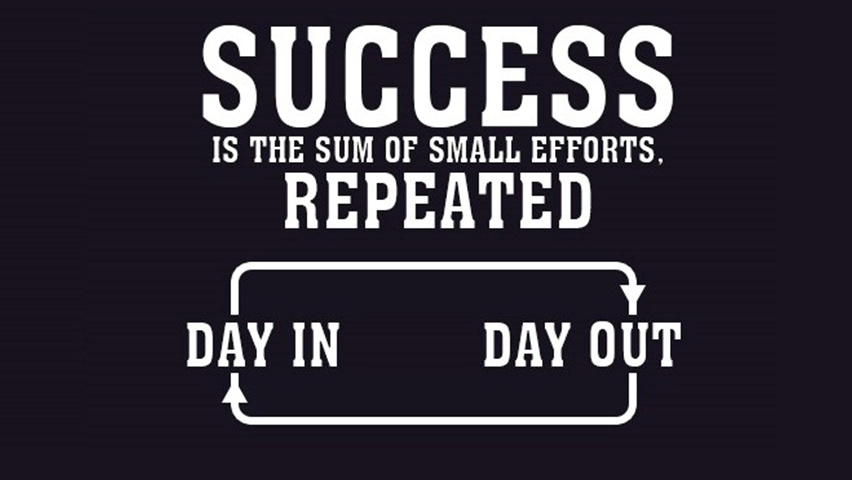Written by Ari Greenbaum, Co-founder of conXpros
“Success is all about consistency around the fundamentals” (Robin Sharma-Writer and leadership speaker). Historically, there are few if any people that have achieved massive success and have done so without consistency. The concept of consistency is practically a super-human trait, as the ones that achieve it typically are well known leaders in their areas of expertise. People by nature are highly inconsistent. Habitual, yes, but consistent, not even close. Unfortunately, “habitual” is more often used to describe a repetitive negative action. Truly successful individuals understand that habitual also must include positive actions. People that are habitual smokers, (I smoked for over 20 years before finally breaking this negative and unhealthy habit) have the “need” to light up when they first wake up in the morning, after every meal, every time the engine is started in our car, before going into a non-smoking area for any given period of time, and many other “necessary” occasions for a smoke. The goal is to elevate positive actions to this conscious and subconscious level. For example, reviewing the confident method of speaking (E-S-P), shared in my recent article “Confidence: The Key to Success in Sales (part 3)”, every day upon readying for work, at the conclusion of every meal, as you travel in your car, before every meeting with a prospect, and any other time that is available. There are many traits, skills, and characteristics that I offer in my blog posts. Every one of them represent ideas of healthy, positive actions and thoughts which you can become “habitual” about. Imagine if you put the same energy into things that will lead to your success as you do to the things that lead to potential death. You want to live, correct? This shift towards consistency is the very substance for success, or for the purpose of this article, living.
I believe it is imperative that one first understands the “why”, before applying tools or concepts to their lives. First, let’s debunk a common myth; that the majority of salespeople know and have their closing ratios. There is a common interaction that takes place in many sales offices/teams, which I have always found amusing. Perhaps you have personally experienced the situation I am about to describe. Typically, this takes place when a new rep is joining a company. In an attempt to gain acceptance with their new peers, engages in a conversation commonly held at the proverbial “water cooler” or other congregation areas. The question of closing ratios is either asked by the newbie to a veteran of the sales team, or vice versa. The responses are irrelevant due to the nature of the question. Salespeople are highly inconsistent in their day to day operations, thus making determining a real “closing ratio” virtually impossible. In grade school, we are taught what a ratio is; a variable (x) compared to a constant (y). It is impossible for a salesperson who by nature is inconsistent in their approach to prospect meetings as well as their day to day routine, to have a closing ratio. There is not the constant that the variable is compared to, resulting in a ratio. Rather there are two variables that sometimes result in success and other times complete disaster. Salespeople rarely have realclosing ratios; however, CLOSERS do. Closers are consistent in our approach to every day, week, month. Consistent in the processes we use with every prospect we meet. Consistent in routine and emotion. We know exactly how many prospects will become customers out of every 10 that we meet because of the consciously practiced trait of consistency.
Consistency facilitates personal improvement and growth. Just as a scientist or inventor makes minor tweaks to next attempt of success after failures, we also must make minor adjustments to our processes and approach to helping meet the needs of potential buyers. It is impossible to steadily improve without a constant baseline to compare results. In the world of online marketing, campaigns are not randomly strung together and then tested, rather multiple ads with minor variations from a consistent base are used. With this approach, the marketer is able to recognize what is working in order to replicate it as well as what minor variations may not be producing results to improve upon or potentially eliminate them. This approach is what you must mirror to ensure that the improvements and successes you experience are identifiable. To know with a high level of certainty, requires the consistency to compare the variables to. There are many other analogies which could be made to better understand this concept, but I feel that you should already start to see the value and power of consistency in our personal and professional development.
Consistency provides the vehicle to turn accountability and self-awareness into growth and self-improvement. Goal setting, planning and more importantly achievement, becomes realistic and expected when consistent in your behaviors and thoughts. Salespeople experience massive swings from good to bad days and back from bad to good. There are many peaks and valleys. With consistency, you essentially eliminate the “bad” days and maximize the “good” days. I am not suggesting that every day is perfection, as that would be misleading. Rather that the valleys are raised to levels which previously would have been viewed as “good” days. This can be better understood by an example from the sports world. Many analysts will project floors and ceilings for players when providing their pre-season projections. The players whom have been consistent year after year, take Lebron James for example, will have high floors comparatively to other players and of course high ceilings. It would be unreasonable to project that a player of James’ consistency would have a scoring average of 15 points per game, when he has been at least 10 points higher every year he has been in the league. This is the same in the world of sales; through consistency your “floor” is higher than most sales professionals, or your propensity to underperform is significantly diminished.
Consistency allows you to project and “predict” results with accuracy. In the 90’s, Mike Tyson, one of the greatest heavyweight boxers of all time. He made quick work of any opponent that would dare step into the ring with him. On the other hand, Evander Holyfield, who fought in the same era as Tyson and also one of the best heavyweights in history, would typically go many rounds into a fight and sometimes the full round limit on his way to victory. If you as a bettor (I am not advocating gambling, only using this as an analogy) were faced with an option to place your money on one of these two fighters when facing their given opponents, who would you choose? I am confident that the choice you made is the same as myself, Mike Tyson. We did not make this choice because he is the better fighter (topic of great debate), but rather because of the predictable nature of Tyson fights. We would rather bet on the “sure thing”, the fast knock out, rather than take the chance on one of Holyfield’s opponents getting “lucky” as the fight went on in rounds. Tyson was the epitome of consistency and you could bet on it. Predictability and projectability are valuable terms to a successful sales pro as well as sales managers. When you are consistent, you are able to know with a slight variation, exactly what you will be earning and what revenues you will be generating. This is one of the many reasons why top producers are so valued to any organization. Every business owner or sales manager desire the ability to project results with accuracy. Consistency is the vehicle that allows accuracy in our forecasting. The unknown breeds fear; however, KNOWING is incredibly comforting.
This article was intended to lay the foundations and understanding for the trait of consistency. In part 2 of this series, I will offer the tools that will allow you to achieve this valuable, superhuman skill. Stay tuned….

